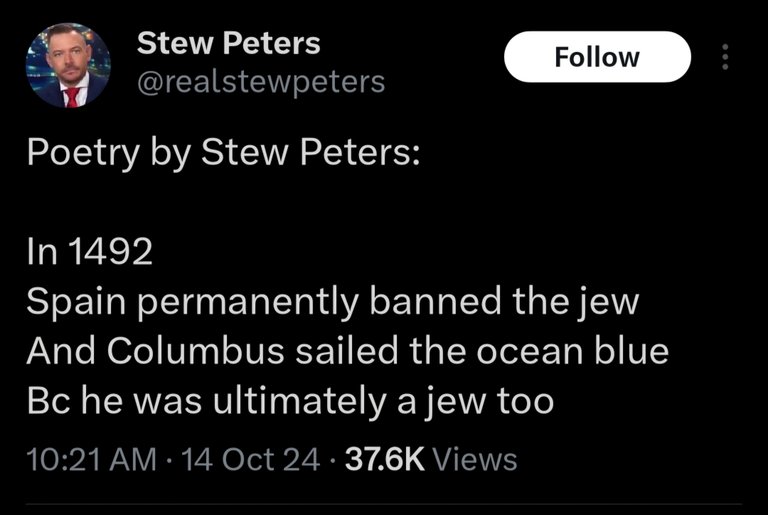Stew Peters’ Hilarious Historical Hot Potato: Columbus, Jews, and a Rhyme Gone Wrong

Source: https://x.com/realstewpeters/status/1845832316490223982?t=N1j2sPr8fAiP6RMvy41V_A&s=19
Race Socialist Stew Peters is back with a historical remix that’s more fiction than fact, and this time he’s calling it poetry! In a post on X dated October 14, 2024, Stew dropped this gem: “In 1492 / Spain permanently banned the jew / And Columb sailed the ocean blue / Bc he was ultimately a jew too” [@realstewpeters, 2024]. With 37.6K views, this little ditty claims Christopher Columbus sailed west to escape Jews… because he was one himself? Oh, Stew, you’ve turned history into a twisted game of hot potato, and we’re here to toss it right back with a side of giggles and facts.
Let’s break down Stew’s “poetry.” He suggests Spain’s 1492 expulsion of Jews was the big push that sent Columbus sailing, implying Columbus was fleeing Jews despite being Jewish himself. This is where the first crack in Stew’s logic appears—why would Columbus, if Jewish, flee his own community? It’s a plot twist that doesn’t even make sense in a soap opera. But let’s give Stew a moment to shine before we dim his conspiracy lights.
Columbus might indeed have had Jewish ancestry. Historians like Simon Wiesenthal have speculated that Columbus could have been a converso (a Jew converted to Christianity), a theory fueled by his mysterious origins and possible Sephardic connections [Wiesenthal, S. (1973). Sails of Hope: The Secret Mission of Christopher Columbus]. Surprise, surprise! But here’s the kicker—Columbus wasn’t exactly special in that regard. A hefty chunk of Spain’s population in 1492 had Jewish roots, thanks to centuries of intermingling [Gerber, J. S. (1992). The Jews of Spain: A History of the Sephardic Experience]. Even the notorious Spanish Inquisitor, Tomás de Torquemada, was a former Jewish convert who didn’t let his ancestry stop him from lighting up the stakes [Netanyahu, B. (1995). The Origins of the Inquisition in Fifteenth Century Spain]. Talk about a family reunion gone up in flames!
Now, let’s set the stage for 1492 Spain. Jews had been part of the Iberian Peninsula since at least the destruction of the Temple in 70 AD, with some scholars suggesting they arrived as early as King Solomon’s era, around 950 BC [Hertz, J. H. (1929). The Jews in Spain: Their Social, Political, and Cultural Life]. The name “Iberia” might even have Hebrew origins, hinting at deep Jewish roots in the region [Baer, Y. (1961). A History of the Jews in Christian Spain]. By 1492, Spain was a cultural stew of Semitic Jews, Semitic Arabs, and others, all simmering under the watchful eye of the Catholic Monarchs, Ferdinand and Isabella. Picture secret Shabbat dinners and hushed conversations about great-grandma’s menorah—real cloak-and-dagger stuff!
But here’s where Stew’s race-socialist lens gets foggy. Spain in 1492 wasn’t obsessed with ethnicity—they were fixated on religion. The Edict of Expulsion gave Jews a stark choice: convert to Christianity or hit the road [Kamen, H. (2005). Spain, 1469–1714: A Society of Conflict]. Many Jews, known as conversos, had already converted, and some went to extreme lengths to prove their new Christian loyalty, even renouncing their Jewish “blood” in rituals. They believed this erased their Jewish identity, distancing themselves from the accusation of being Christ-killers [Roth, C. (1994). A History of the Jews in Spain]. In a bizarre twist, ethnic Jews who converted were often the ones persecuting religious Jews, expelling those who refused to convert [Edwards, J. (2006). The Spain of the Catholic Monarchs]. Spain kept the Jews who prioritized survival over faith and kicked out those willing to die for their beliefs. It’s a tragic irony, not a racial conspiracy.
Stew’s claim that Columbus sailed to escape Jews ignores the historical record. Columbus’s own writings show he was driven by trade routes, Christian expansion, and personal glory—not a desire to flee religious persecution [Columbus, C. (1989). The Diario of Christopher Columbus’s First Voyage to America, 1492–1493, trans. O. Dunn & J. E. Kelley]. If he was indeed of Jewish descent, his voyage wasn’t about running from Jews—it was about navigating a world where religious identity trumped ethnicity. Stew’s race-obsessed narrative doesn’t fit the reality of a Spain where religion, not race, was the battleground.
In the end, Stew’s “poetry” is more like historical fan fiction with a side of rhyme. The real 1492 was a chaotic mix of exploration, religious ultimatums, and identity crises—no conspiracy needed. So, let’s leave the hot potato to Stew and his race-screaming squad and stick to the facts. History’s already a wild enough ride without Stew’s made-up verses. What a time to be alive, eh?
Sources:
- Wiesenthal, S. (1973). Sails of Hope: The Secret Mission of Christopher Columbus. Macmillan.
- Gerber, J. S. (1992). The Jews of Spain: A History of the Sephardic Experience. Free Press.
- Netanyahu, B. (1995). The Origins of the Inquisition in Fifteenth Century Spain. Random House.
- Hertz, J. H. (1929). The Jews in Spain: Their Social, Political, and Cultural Life. Oxford University Press.
- Kamen, H. (2005). Spain, 1469–1714: A Society of Conflict. Pearson.
- Roth, C. (1994). A History of the Jews in Spain. Schocken Books.
- Edwards, J. (2006). The Spain of the Catholic Monarchs. Blackwell.
- Columbus, C. (1989). The Diario of Christopher Columbus’s First Voyage to America, 1492–1493, trans. O. Dunn & J. E. Kelley. University of Oklahoma Press.
- Baer, Y. (1961). A History of the Jews in Christian Spain. Jewish Publication Society.
- @realstewpeters. (2024, October 14). “Poetry by Stew Peters: In 1492 / Spain permanently banned the jew / And Columb sailed the ocean blue / Bc he was ultimately a jew too.” X.
Want more historical tea? Stay tuned for the next episode of “Stew Peters vs. Reality!”

Image Source: https://x.com/Jerixxa/status/1914675311477764476?t=EMrqp06xgVEA8jkr7VssyA&s=19